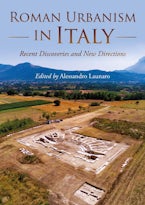The main concern of this volume is the multi-layered concept of ethnicity. Contributors examine and contextualise contrasting definitions of ethnicity and identity as implicit in two perspectives, one from the classical tradition and another from the prehistoric and anthropological tradition. They look at the role of textual sources in reconstructing ethnicity and introduce fresh and innovative archaeological data in reconstructing ethnicity, either from fieldwork or from new combinations of old data. Finally, in contrast to many traditional approaches to ethnicity, they examine the relative and interacting role of natural and cultural features in the landscape in the construction of ethnicity.
The volume is headed by the contribution of Andrea Carandini whose work challenges the conceptions of many in the combination of text and archaeology. He begins by examining the mythology surrounding the founding of Rome, taking into consideration the recent archaeological evidence from the Palatine and the Forum. Here primacy is given to construction of place and mythological descent. Anthony Snodgrass, Robin Osborne, Tim Cornell and Christopher Smith offer replies to his arguments. Overall, the nineteen papers presented here show that a modern interdisciplinary and international archaeology that combines material data and textual evidence - critically - can provide a powerful lesson for the full understanding of the ideologies of ancient and modern societies.
1. Introduction: contextualising ethnicity (Gabriele Cifani and Simon Stoddart)
2. Urban landscapes and ethnic identity of Early Rome (Andrea Carandini)
Comments (T. Cornell, C. Smith, A. Snodgrass and R. Osborne)
3. Landscape, ethnicity, and the Greek polis (Robin Osborne)
4. The discovery of Carian Melia and the archaic Panionion in the Mycale (Hans Lohmann)
5. Multi-ethnicity and population movement in Ancient Greece (John Bintliff)
6. Hybrid forms of identity (Greek/native Italic) on the border between Taranto and the Messapians (Gert-Jan Burgers)
7. Before the Samnites: Molise in the eighth and sixth century BC (Alessandro Naso)
8. Ethnicity, identity and state formation in the Latin Landscape. Problems and Approaches (Francesca Fulminante)
9. Ethnicity and identity of the Latins. Evidence from the sanctuaries between the sixth and the fourth centuries BC (Letizia Ceccarelli)
10. Political landscapes and local identities in Archaic central Italy – Interpreting the material from Nepi (VT, Lazio) and Cisterna Grande (Crustumerium, RM, Lazio) (Ulla Rajala)
11. Landscapes and ethnic frontiers in the middle Tiber valley (Gabriele Cifani)
12. The Grotte di Castro project: defining a boundary of identity (Gabriele Cifani, Letizia Ceccarelli and Simon Stoddart)
13. Between text, body and context: expressing Umbrian identity in the landscape (Simon Stoddart)
14. Space, boundaries and the representation of identity in the ancient Veneto (Kathryn Lomas)
15. Identities, Frontiers and Landscapes in the Guadalquivir Valley (Eighth century BC- fourth century BC) (Arturo Ruiz and Manuel Molinos)
16. Landscape and Ethnic Identities in the Iberian Early States: The example of the Eastern Iberian Peninsula (Ignacio Grau Mira)
17. The politics of identity: ethnicity and the economy of power in Iron Age northern Iberia (Alfredo González-ruibal)
18. Changing identities in a changing landscape: social dynamics from a colonial situation in early Iron Age Iberia (Jaime Vives-ferrándiz)
19. Endnote: Situating Ethnicity (Simon Stoddart and Skylar Neil)
Simon Stoddart is Reader in Prehistory at the University of Cambridge. His many research interests include Iron Age Europe, island societies encompassing his work on Malta with the Gozo Project, and landscape archaeology. His publications include Landscape, Ethnicity and Identity (2012, ed with G. Cifani and S. Neil), and Historical Dictionary of the Etruscans (2009). He was editor of Antiquity from 2001-2002.












